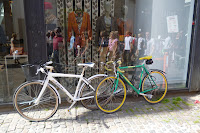 I guess most of us know that certain European cities take a different approach to things in general and urban planning in particular. Well Copenhagen is a Melbourne cyclists dream come true. There were bikes and cyclists everywhere throughout the city...
I guess most of us know that certain European cities take a different approach to things in general and urban planning in particular. Well Copenhagen is a Melbourne cyclists dream come true. There were bikes and cyclists everywhere throughout the city...There are probably more cyclists than even pedestrians as it is simply the best way to get around the inner suburbs. There is very little traffic even on through roads in the inner areas and certainly no traffic jams.
They have many less signals and signs, pedestrians and cyclists (without helmets, no lycra, all dressed for their destination) simply weave around each other in pedestrianised areas and none of the cyclists seem in any hurry as they are going faster and more directly to their destinations anyway.
Central Copenhagen is a pretty well preserved mixture of narrow medieval streets and (mostly) later buildings from the middle ages onwards. Outside the old city boundaries the more rectangular streetscapes reflect 19th and 20th century expansion and development.
It's possible to see the vague outline of the old town and its watery defences reflected in the pattern of line of parks (Orsted Parken, Botanical Gardens and Ostre Anlaeg) to the north-west of the city centre and to the south east of Christianshavn, the island just across the river.
The generally flat topography certainly helps with cycling but, as there is no real competition with traffic and few hold-ups, there is just not the same urgency that we find in Melbourne. In fact the whole place just seems more relaxed. Employment, housing, education and transport are more integrated and enmeshed with each other here and long commutes are the exception but, if necessary, can be easily achieved with excellent public transport over longer distances.
We went to the Danish Museum of Architecture which has an exhibition, CopenhagenX, which is an updated and expanded version of Denmark's contribution to the 12th International Architecture Exhibition in Venice 2010 on the theme of 'What makes liveable city?' and it is fantastic. There is a range of transport, urban renewal and industrial/commercial projects all integrated to improve the liveability of Copenhagen and the surrounding region. Most of the featured projects/programs are underway (many are complete already) and the planning and implementation has been going on consistently for at least 30 years.
Significantly they are prepared to make decisions, and favour cycling and public transport over vehicles for moving people about. They also are reinvigorating the inner ring of suburbs which were gradually emptied as people moved to the new suburbs in the 50/60s. They have done fantastic work on bike lanes etc and are building more metro lines to link a ring of redeveloped areas to existing lines. Despite already having surface line links to the airport they have opened the M2 metro line in 2007 which now runs there as well - it takes about 10 mins to the city centre with 3 or 4 stops.
The striking thing to me is that there is not one mention anywhere of costs, which would be the first question asked in Australia. These are simply solid investments in the future of the Copenhagen area and are what the councils are there to do. There is none of the grandstanding and politicking we have to get past in Australia to get anything other than a new road built.
I would suggest that every prospective politician and most of our planners should be sent here for 3 days to just visit and absorb the lessons from the exhibition and to witness the effects these approaches have on the quality of life here. The lessons on transport and liveability are equally applicable to major cities, metro areas and regional towns in Australia.
But enough of the lecture. :)
These guys were all over the place as part of an open air art exhibition. The elephants, that is ...

We also took a canal-boat tour, visited the medieval ruins beneath the Christiansborg Palace, the former royal residence which has been burnt down and rebuilt in ever more grand style 3 times in 500 years, and its Royal Reception Rooms.

The Round Tower, with its 200m spiral ramp, also offers the best view of the relatively flat city.


We saw the changing of the guard at Amalienborg Palace, the current Royal residence (didn't spot Prncess Mary ...) and wandered the seafront back to Nyhavn, the busy focus of the city's tourist trails.
The National Museum has enough Danish history and pre-history to keep anyone happy and the small but perfectly formed Danish Design Centre reflects the modern post-war Denmark.
A large portion of the old central city area is pedestrianised.
We walked everywhere, and even cycled little.
We enjoyed some nice local lunches and dinner out on our last night, but generally used the apartment as a base for meals as we were so close to everything anyway, although it was 3 floors and 6 flights of steep stairs up. t's alwys interesting to see how local people live and renting aprtments from owners is a great way to do this.

Copenhagen is an interesting mix of old and new, and has its own distinctive character, different from any other city we've visited. We have spent a week here - off to Stockholm tomorrow.






No comments:
Post a Comment
I will moderate comments if required so please be nice :)